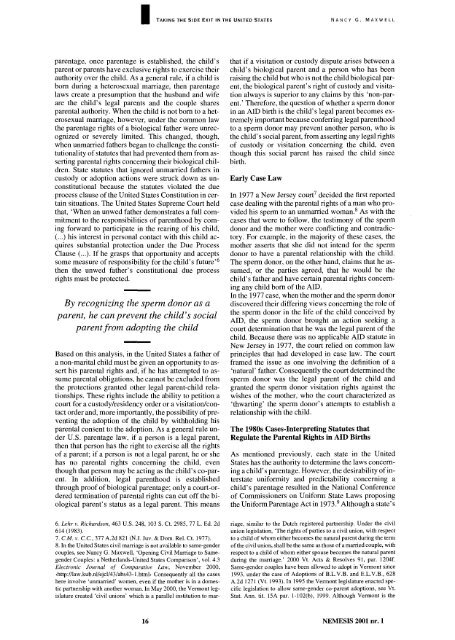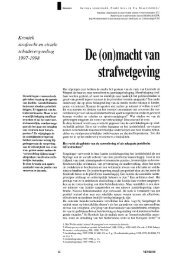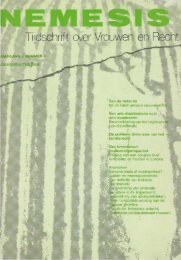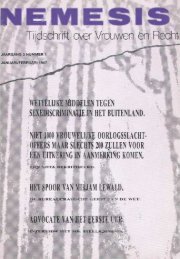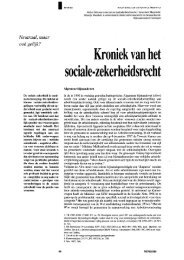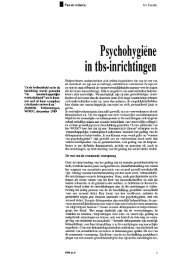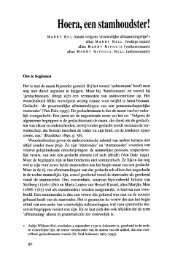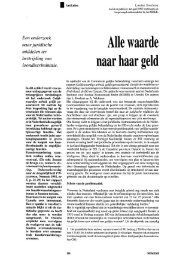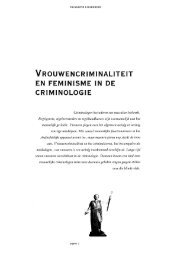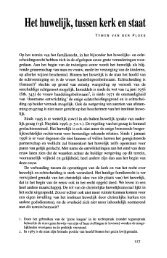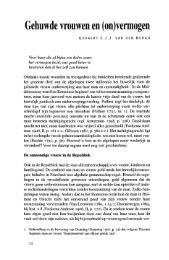(2001) nummer 1 januari/februari - Nemesis
(2001) nummer 1 januari/februari - Nemesis
(2001) nummer 1 januari/februari - Nemesis
You also want an ePaper? Increase the reach of your titles
YUMPU automatically turns print PDFs into web optimized ePapers that Google loves.
I TAKING<br />
parentage, once parentage is established, the child's<br />
parent or parents have exclusive rights to exercise their<br />
authority over the child. As a general rule, if a child is<br />
born during a heterosexual marriage, then parentage<br />
laws create a presumption that the husband and wife<br />
are the child's legal parents and the couple shares<br />
parental authority. When the child is not born to a heterosexual<br />
marriage, however, under the common law<br />
the parentage rights of a biological father were unrecognized<br />
or severely limited. This changed, though,<br />
when unmarried fathers began to challenge the constitutionality<br />
of statutes that had prevented them from asserting<br />
parental rights conceming their biological children.<br />
State statutes that ignored unmarried fathers in<br />
custody or adoption actions were struck down as unconstitutional<br />
because the statutes violated the due<br />
process clause of the United States Constitution in certain<br />
situations. The United States Supreme Court held<br />
that, 'When an unwed father demonstrates a full commitment<br />
to the responsibilities of parenthood by coming<br />
forward to participate in the rearing of his child,<br />
(...) his interest in personal contact with this child acquires<br />
substantial protection under the Due Process<br />
Clause (...). If he grasps that opportunity and accepts<br />
some measure of responsibility for the child's future' 6<br />
then the unwed father's constitutional due process<br />
rights must be protected.<br />
By recognizing the sperm donor as a<br />
parent, he can prevent the child 's social<br />
parent from adopting the child<br />
Based on this analysis, in the United States a father of<br />
a non-marital child must be given an opportunity to assert<br />
his parental rights and, if he has attempted to assume<br />
parental obligations, he cannot be excluded from<br />
the protections granted other legal parent-child relationships.<br />
These rights include the ability to petition a<br />
court for a custody/residency order or a visitation/contact<br />
order and, more importantly, the possibility of preventing<br />
the adoption of the child by withholding his<br />
parental consent to the adoption. As a general rule under<br />
U.S. parentage law, if a person is a legal parent,<br />
then that person has the right to exercise all the rights<br />
of a parent; if a person is not a legal parent, he or she<br />
has no parental rights conceming the child, even<br />
though that person may be acting as the child's co-parent.<br />
In addition, legal parenthood is established<br />
through proof of biological parentage; only a court-ordered<br />
termination of parental rights can cut off the biological<br />
parent's status as a legal parent. This means<br />
THE SIDE EXIT IN THE UNITED STATES NANCY G. MAXWELL<br />
that if a visitation or custody dispute arises between a<br />
child's biological parent and a person who has been<br />
raising the child but who is not the child biological parent,<br />
the biological parent's right of custody and visitation<br />
always is superior to any claims by this 'non-parent.<br />
' Therefore, the question of whether a sperm donor<br />
in an AID birth is the child's legal parent becomes extremely<br />
important because conferring legal parenthood<br />
to a sperm donor may prevent another person, who is<br />
the child's social parent, from asserting any legal rights<br />
of custody or visitation conceming the child, even<br />
though this social parent has raised the child since<br />
birth.<br />
Early Case Law<br />
In 1977 a New Jersey court 7 decided the first reported<br />
case dealing with the parental rights of a man who provided<br />
his sperm to an unmarried woman. 8 As with the<br />
cases that were to follow, the testimony of the sperm<br />
donor and the mother were conflicting and contradictory.<br />
For example, in the majority of these cases, the<br />
mother asserts that she did not intend for the sperm<br />
donor to have a parental relationship with the child.<br />
The sperm donor, on the other hand, claims that he assumed,<br />
or the parties agreed, that he would be the<br />
child' s father and have certain parental rights conceming<br />
any child bom of the AID.<br />
In the 1977 case, when the mother and the sperm donor<br />
discovered their differing views conceming the role of<br />
the sperm donor in the life of the child conceived by<br />
AID, the sperm donor brought an action seeking a<br />
court determination that he was the legal parent of the<br />
child. Because there was no applicable AID statute in<br />
New Jersey in 1977, the court relied on common law<br />
principles that had developed in case law. The court<br />
framed the issue as one involving the definition of a<br />
'natural' father. Consequently the court determined the<br />
sperm donor was the legal parent of the child and<br />
granted the sperm donor visitation rights against the<br />
wishes of the mother, who the court characterized as<br />
'thwarting' the sperm donor's attempts to establish a<br />
relationship with the child.<br />
The 1980s Cases-Interpreting Statutes that<br />
Regulate the Parental Rights in AID Births<br />
As mentioned previously, each state in the United<br />
States has the authority to determine the laws conceming<br />
a child's parentage. However, the desirability of interstate<br />
uniformity and predictability conceming a<br />
child's parentage resulted in the National Conference<br />
of Commissioners on Uniform State Laws proposing<br />
the Uniform Parentage Act in 1973. 9 Although a state' s<br />
6. Lehr v. Richardson, 463 U.S. 248, 103 S. Ct. 2985, 77 L. Ed. riage, 2d similar to the Dutch registered partnership. Under the civil<br />
614(1983).<br />
union legislation, 'The rights of parties to a civil union, with respect<br />
7. C.M. v. CC, mi A.2d 821 (NJ. Juv. & Dom. Rel. Ct. 1977). to a child of whom either becomes the natural parent during the term<br />
8. In the United States civil marriage is not available to same-gender of the civil union, shall be the same as those of a married couple, with<br />
couples, see Nancy G. Maxwell, 'Opening Civil Marriage to Same- respect to a child of whom either spouse becomes the natural parent<br />
gender Couples: a Netherlands-United States Comparison', vol. 4.3 during the marriage.' 2000 Vt. Acts & Resolves 91, par. 1204f.<br />
Electronic Journal of Comparative Law, November 2000, Same-gender couples have been allo wed to adopt in Vermont since<br />
Consequently all the cases 1993, under the case of Adoptions of B.L.V.B. and E.L.V.B., 628<br />
here involve 'unmarried' women, even if the mother is in a domes- A.2d 1271 (Vt. 1993). In 1995 the Vermont legislature enacted spetic<br />
partnership with another woman. In May 2000, the Vermont legcific legislation to allow same-gender co-parent adoptions, see Vt.<br />
islature created 'civil unions' which is a parallel institution to mar- Stat. Ann. tit. 15A par. l-102(b), 1999. Although Vermont is the<br />
16<br />
NEMESIS <strong>2001</strong> nr. 1


